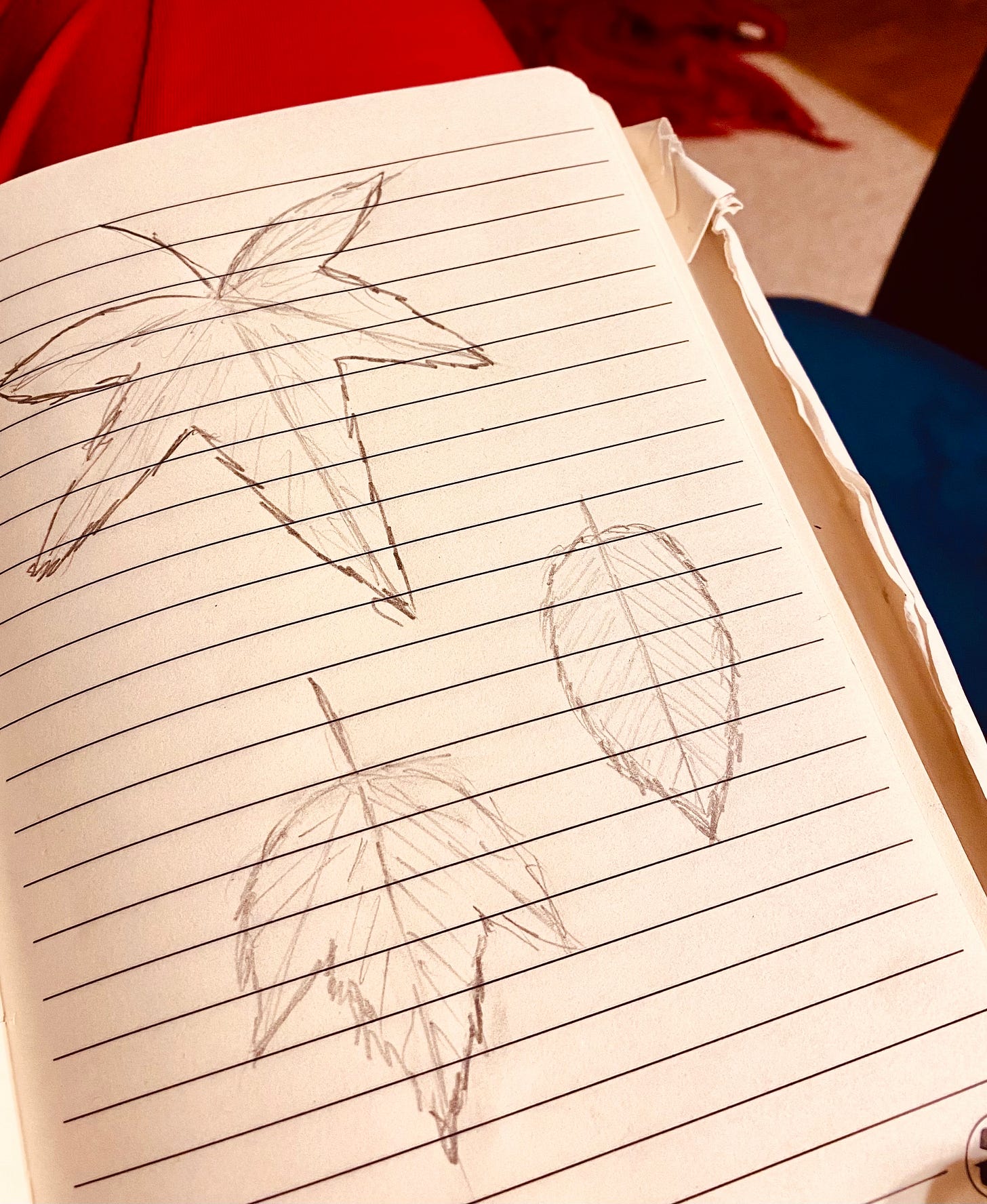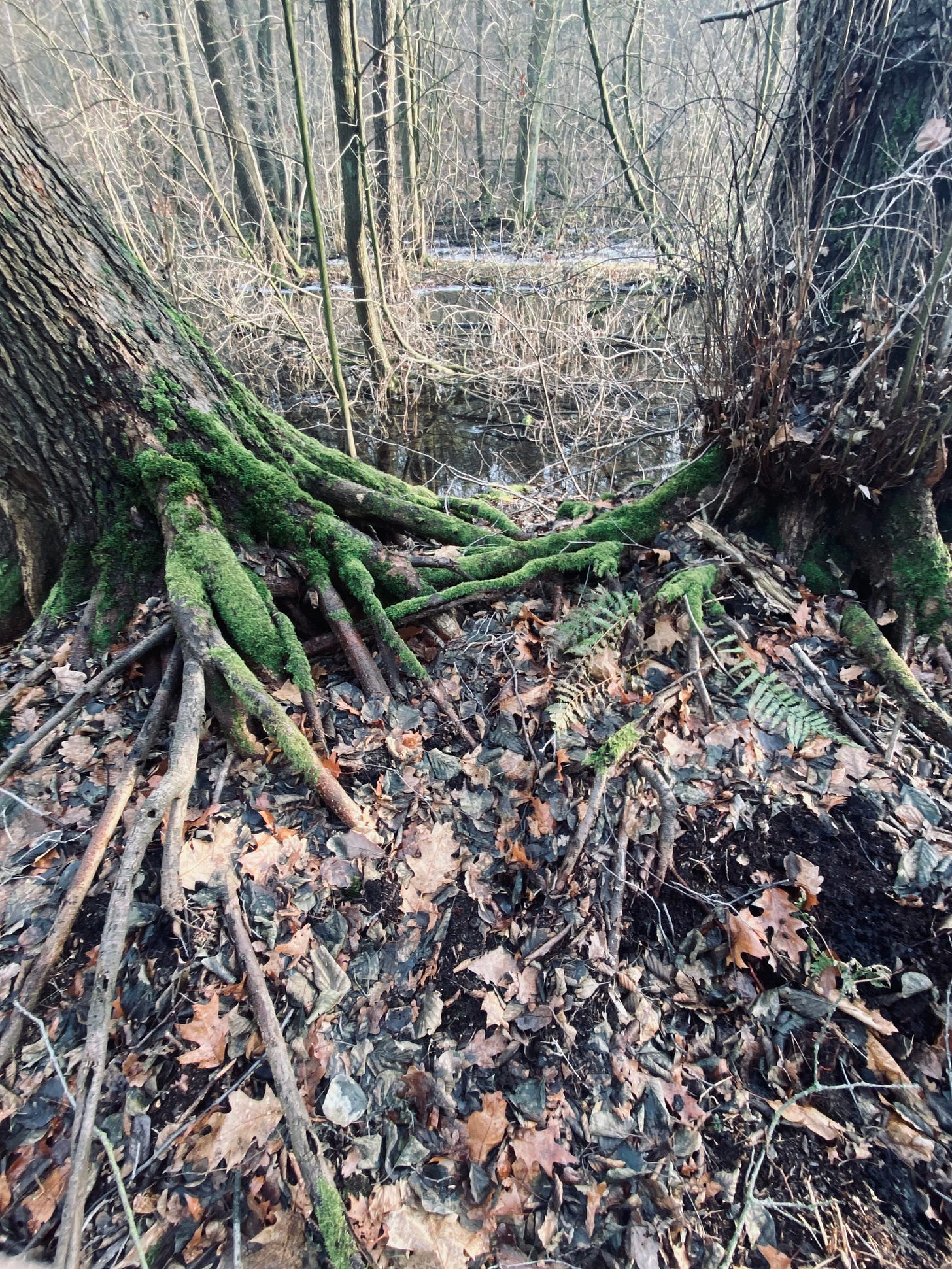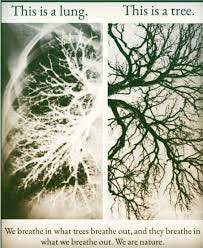How to find joy, clarity, and meditative flow by connecting to trees
Launching monthly Breath Walks in Berlin
The human mind developed in a world of animals and plants, and it cannot be fully at home in a world devoid of them."
The Others: How Animals Made Us Human, by Paul Shepard
“I could leave you by the window for hours in your pram as long as there was wind. You would just stare at the swaying trees.”
That’s one of my few childhood stories that gives me a glimpse into my natural inclinations. ”What did you like to do as a child?” kind of inclinations.
I used to go blank every time I would get it. Thought something must be wrong with me, my childhood, and (of course) my parents… Oooph, a sigh of relief. I’ve got an answer now: “I guess I was into trees.” It feels so good to remember.
Trees and you: mutual benefits
I got so much more than I had ever hoped for as I started to spend more time with trees. It started as homework for my Wilderness Educator course. Reading some books on science and mythology, browsing through pics, exploring leaves, etc.
I was taking a walk in the forest one day and realized. I really see the trees. Meaning they all look different to me as opposed to trees as background. And I have a list in my head: “This is who I am visiting this time”.
I believe that the sense of void and the emotional flatness many of us experience is often a lack of deep connection to nature. Nature as our home, nature as us. It’s as if you are a stranger in your own family.
Trees, to me, are perfect beings for deepening connection to nature. We have some cool commonalities with trees that are easy to explore, we have this innate fascination with trees as big and ancient beings, and it’s easy to start interacting with trees in any season.
So sharing some simple tips on how to join that party. But before, here is what you could expect:
Having an adventure by just getting outside, no matter the weather or the season
Clarity and insights that feel like they are emerging out of the connection
A feel-it-in-your-bones sense of belonging to something bigger
Developing and trusting your intuition
Having no-effort meditative time
So here are some simple ways to start an interspecies tree-to-human relationship that opens us to the world outside our skulls and enriches our lives.
Why is this relationship mutually beneficial? Because when we have this deep interspecies connection, our instinctive response is to see ourselves as guardians. Of the species and of the land. And our actions and decisions follow.
It starts with one relationship
Every relationship starts with genuine curiosity. With trees, just as with people. “Is there a vibe between us?” Is it enough to be wanting to learn more about each other?
Because what we want is a deeper connection. Not the kind where we see this neighbor every other day, but hardly know or have an inclination to know anything about them.
Here are a few tips:
Better to pick a tree that you have in relative proximity. My entry point was a tree that I can see through the window as I wake up. It almost called on me when I cared enough to pay attention.
That said, the vibe and curiosity play a big role. Maybe you have a tree species or a tree that you have some history with or feel it’s calling you. Trees with twisted trunks (=injuries, trauma) always have my attention.
It could be good to start with major tree species local to your area. They have a long history with humans and lots of “lore“ that brings alive the character of the species and gives lots of “get-to-know-each-other“ material for “future dates.“
Observe to SEE
You know how we often look but don’t necessarily see? How we listen to but don’t really hear? So, we want to make time for focused attention.
Even more so since the exchange will be non-verbal. So, you will be called on to open up your senses. Btw we have 53 of them according to some biologists.
You can approach it as “an embodied meditation.” Which means observing the tree or its parts visually, listening, smelling, etc. And at the same time staying aware of what sensations, feelings or impulses emerge inside of you.
You can also call the self-observation practicing interoceptive awareness. In other words, sensing yourself and being aware of the rich inner life that will be responding to spending time with trees.
Interoception is considered to be the foundation of our emotional regulation and the seat of our intuition. I wrote about it here.
Relationships: sharing of energy and information flow
The exchange that happens as you give your focus to the tree is very real in neurobiological terms. Your mind is now interacting with the tree and changing in the process. As trees are sentient beings, the flow is bi-directional.
Let me share with you a definition of mind by a researcher and professor of clinical psychiatry at UCLA, Dan Siegel, in this context:
“The human mind is, in a very real sense, much bigger and more expansive than the skull that we imagine to house it. Specifically, relationships are the sharing of energy and information flow. The brain and its whole body are the embodied mechanism of that flow, and the mind is the self-organizing process that regulates that flow.”
In other words, the mind is not a box. It is a process: a constant exchange of information and energy with the world around us.
Dr. Siegel came up with a special term to reflect this ever-evolving-with-the-others nature of the mind: M-We. Which means we are never alone, always Me+We. And the shape of the M-We at any given moment is determined by where we choose to direct our limited focus.
Me+My Mac
Me+Instagram
Or
Me+This Tree
I vote for the last one, you have probably guessed.
Observe to draw from memory practice
A simple and profound (for me) practice is visually exploring the tree, or its part, e.g. the bark (=skin) or the leaves when they are there, with an intention to draw those from memory.
Nature has intricately beautiful, complex, and wise designs. Every tiny organism is a universe, just often invisible to the human eye.
But see what your eye can detect. And then be real and do draw it. And I am terrible at drawing as well, if this excuse has crossed your mind. But it’s not about a good drawing. It’s about building a relationship.

Questions to ponder for further exploration
What has this tree seen? Maybe some historical events or maybe it has seen you as a baby and witnessed some family events.
What can you imagine looking at the tree, the shape of the trunk, the location of the branches, its neighbors about its life and history?
Are there any myths, tales or stories about the tree? If yes, which characteristics do they highlight?
Respect and reciprocity
You noticed that out of all senses, I started with visual observation. I was careful in inviting you to touch, hug, peel off the bark, etc. That’s because in line with a human relationship, the one with trees is also built on respect and reciprocity.
Some also call it reverence. Reverence to nature had been the foundation of human-nature relationships for thousands of years and, still passed from generation to the next in indigenous cultures.
Treat something with reverence and it becomes something very special, right? So, no matter where you stand on trees understanding you or not, let the vibe of it be: “I respectfully see you as a being.” It’s this intention that the sense of awe and joy are coming from.
Reciprocity rituals
What do respect and reciprocity mean to you in a human relationship? You can draw from that meaning to establish rituals in relationship with a tree.
Here are some ideas to consider:
Start by introducing yourself, mentally ask for permission before touching, hugging, harvesting leaves, bark or branches.
By the way, this is not to say you should keep the distance. Because the coolest awe-filled moments come from contact. Like sitting under a tree, exploring the bark, the leaves, etc. The invitation is to be respectful and mindful about initiating that close contact.
Bring gifts. Symbolic gifts. I’ve read from experts in some traditions, like druidry, to those who feel drawn to trees, and they mention: a handful of any grain like corn, herbal tea, ashes (from your last night’s fire ;))). And also singing, dancing, bowing.
Breathing with the trees
I’ll end with why I might be so drawn to trees. Because we share breathing and breath. And we all do on this planet.
But as you might have heard me talk about it before: we share the lungs, and we use them in a beautiful symbiotic relationship. So check them out side by side: the exact replicas, your bronchial tree, and a forest tree.
And as you make an inhale, keep in mind that you owe it to the exhale of the trees and other plants. And as you exhale the CO2, or your car does, or the production of a computer did that you might be using right now, the trees are breathing it in and exhaling oxygen for our next breath.
I find it ecstatically fascinating and gratitude-inducing. And if you feel even remotely the same, try breathing with trees. You can breathe in any shape or form or take the below ritual as inspiration.
A breathing ritual
Find a place from which you can observe the tree. Or, if the weather and life allow, sit under the tree. Experiment with picking a spot and a side, as it can make a difference.
As it’s winter right now and most of the trees are hibernating and not active, consider a coniferous tree, like a pine.
I fell in love with pines as I learned about their connection to breathing. Logical if you think about the essential oil it produces. They help to move out of stuckness: physical, like phlegm, or emotional, like a depressive state. So, consider if any of this resonates.
When you’ve found your spot, take a comfortable position. Spine straight, shoulders low and open. Now sense your breath. Inhaling and exhaling without changing anything. Visualize the forest and bronchial trees and our symbiotic relationship.
Coherent breath
You can then transition to what’s called a coherent breath. As the name suggests, this breath is very well researched for its effect of bringing different parts of a complex system that we are into coherence.
Your heart and your lungs, and your liver and brain. And then you and the tree, you and the forest.
Coherence is promoted when the length of the inhale and exhale taken together is about 10 seconds. Which leaves you with two main options:
Option 1: Equal inhales and exhales: 5 counts each
Option 2: Inhale for 4 counts, exhale for 6 counts.
Consider breathing for ten minutes. Reflect afterward.
That’s it for this week. It’s quite long, I realize, but I am gravitating to this format as it gives me a chance to explain myself to you. And hopefully, it gives something to you as well.
As always, hearing from you means the world to me. So if there is anything that asks to be said or shared, please consider pressing the button below.
See you next Friday.
Breathe light,
Yulya
How you can further explore with me:
In Berlin: Join Breathing with Nature walks
The first one is coming up on March 15th! You can join here.
1:1 online journeys
Discover joy, aliveness, and a sense of purpose by connecting to the wild inside and beyond. A series of five 90-minute zoom journeys: let me guide you in exploring yourself, finding adventure in the mundane, and remembering that you are nature.
Collaborations
Creativity and change emerge when we get together. If you have an idea of how we could work together, do get in touch. Would be delighted to hear from you!
Stay in touch by subscribing to my Substack, my only writing space for now. I share stories, insights, and recorded guided practices here.








